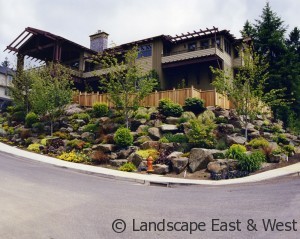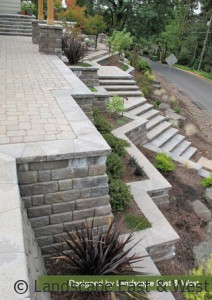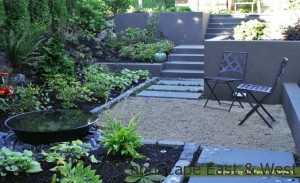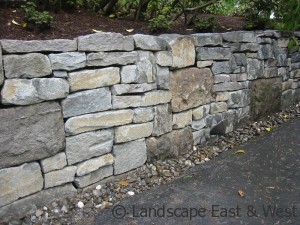Making the Most of a Sloped Lot: Retaining Walls for Portland Landscaping, by Susan Hicks
 Every locale presents its own unique challenges for gardeners. When landscaping Portland, Oregon, many would-be gardeners are confronted with sloped lots. The Portland area features plenty of ravines, bluffs, creeks, hills, and excavations, adding visual interest—and landscaping challenges. Here are a handful of the obstacles associated with uneven property.
Every locale presents its own unique challenges for gardeners. When landscaping Portland, Oregon, many would-be gardeners are confronted with sloped lots. The Portland area features plenty of ravines, bluffs, creeks, hills, and excavations, adding visual interest—and landscaping challenges. Here are a handful of the obstacles associated with uneven property.
Water runoff. Sloped lots can see high water flow, potentially leading to erosion problems, and threatening your property’s foundation. Mudslides may even occur in extreme cases.
Difficulty accessing and enjoying property. A steep slope makes it almost impossible to use your land. The tricky footing of a hillside lot makes it challenging to enjoy.
Dangerous to mow the lawn. Just maintaining your Portland landscaping can be a real challenge when the ground is uneven.
 Fortunately, retaining walls can help minimize or completely erase these problems. Retaining walls are landscaping structures that hold back earth and create a usable space for sloped lots. They may be designed as terraces or single-layer walls. Benches and decorative planting areas can be included in a retaining wall design.
Fortunately, retaining walls can help minimize or completely erase these problems. Retaining walls are landscaping structures that hold back earth and create a usable space for sloped lots. They may be designed as terraces or single-layer walls. Benches and decorative planting areas can be included in a retaining wall design.
By adding retaining walls to sloped properties, Portland landscaping professionals can create accessible, usable space. What you do with that space depends on your family’s needs. Here are a few of the many options a retaining wall can allow you to do:
- Add a water feature.
- Create a destination room.
- Add storage.
- Create a children’s play area.
- Include a kennel.
- Build an outdoor kitchen.
- Finally have the vegetable garden of your dreams.
…And much more! This is by no means the limit of available options. As we’ve been serving Portland, Oregon since 1980, we are able to present homeowners with a wide variety of choices as far as retaining wall design goes.
 For instance, creative homeowners may wish to add living retaining walls, sometimes called green walls. Your designer can create the wall to include pockets of soil, or you can simply grow cascading species at the top, and allow them to drape gracefully down the wall. Vertical gardening is a great way to make the most of your space, and it’s also an accessible form of gardening. You can plant strawberries on your wall, and pick them while standing up! Cucumbers, melons, and tomatoes also love to grow vertically, and they benefit from the heat of the wall as well. People with disabilities will love interacting with your live retaining wall; the vertical element is universally appealing, as it allows for up-close-and-personal interaction with plants. Kids will also get a kick out of smelling, feeling, and examining what’s growing on your retaining wall. Vertical gardening can be as simple as tucking into cracks between retaining wall stones.
For instance, creative homeowners may wish to add living retaining walls, sometimes called green walls. Your designer can create the wall to include pockets of soil, or you can simply grow cascading species at the top, and allow them to drape gracefully down the wall. Vertical gardening is a great way to make the most of your space, and it’s also an accessible form of gardening. You can plant strawberries on your wall, and pick them while standing up! Cucumbers, melons, and tomatoes also love to grow vertically, and they benefit from the heat of the wall as well. People with disabilities will love interacting with your live retaining wall; the vertical element is universally appealing, as it allows for up-close-and-personal interaction with plants. Kids will also get a kick out of smelling, feeling, and examining what’s growing on your retaining wall. Vertical gardening can be as simple as tucking into cracks between retaining wall stones.
Usability issues are probably at the forefront of homeowners’ minds when adding a retaining wall. However, engineers and contractors would probably highlight the erosion benefits over everything else. A retaining wall is a long-term protective structure, keeping excess moisture off your property and protecting buildings’ foundations. Because a retaining wall may need to hold back tons of dirt and rock, it’s important to make sure your landscaping contractors are licensed, experienced experts in how to safely construct an effective retaining structure. Below, we also consider the environmental impact of constructing a retaining wall.
 Important Considerations for Building a Retaining Wall
Important Considerations for Building a Retaining Wall
a. Health & Safety. An expert Portland landscaper can determine which way the water is flowing on and around your slope. Special design precautions must be taken if water is draining toward your home or any other structure. Once a safe design is complete, the landscaper will then clean up the sloped area, and build the wall in a structurally sound way.
Any retaining wall over 2.5 feet requires specialized engineering. If not properly designed, the hydraulic pressure of water behind your retaining wall can cause the wall to fail, leading to dangerous erosion.
Moreover, the City of Portland requires a building permit for any retaining wall that will be more than three feet in height, or any wall that holds an additional weight beyond the normal backfill of level earth. For instance, if your retaining wall is located at the bottom of a slope, it must be designed to hold back more than just the level earth behind it; it must also support the additional load of the hill.
b. Source Locally.
 Retaining wall materials are quite heavy, so they incur a big transportation carbon footprint. That’s why we recommend opting for local stones and other retaining wall ingredients. Portland landscaping aficionados are fortunate to have so many local retaining wall options. Driving around the Rose City, you may have spied volcanic retaining walls constructed from basalt or other volcanic materials. We are also lucky to have block and paver manufacturers in Oregon, so nearly all retaining wall options can be sourced locally.
Retaining wall materials are quite heavy, so they incur a big transportation carbon footprint. That’s why we recommend opting for local stones and other retaining wall ingredients. Portland landscaping aficionados are fortunate to have so many local retaining wall options. Driving around the Rose City, you may have spied volcanic retaining walls constructed from basalt or other volcanic materials. We are also lucky to have block and paver manufacturers in Oregon, so nearly all retaining wall options can be sourced locally.
From wood to concrete to stone to boulders, we can source any type of retaining wall material to perfectly compliment your home. Our in-house design experts will work with you to determine which material and design is best for your needs and your landscaping. If you’ve been held back by a sloped yard, our retaining wall experts can help you reclaim your yard and turn it into a beautiful, usable space that the whole family can enjoy.
 Susan Hicks is the Design-Build Sales expert at Landscape East & West, Portland landscaping professionals. Susan specializes in helping clients with custom retaining wall designs in order to create more usable and functional spaces. Learn more about Landscape East & West’s retaining wall design services.
Susan Hicks is the Design-Build Sales expert at Landscape East & West, Portland landscaping professionals. Susan specializes in helping clients with custom retaining wall designs in order to create more usable and functional spaces. Learn more about Landscape East & West’s retaining wall design services.
